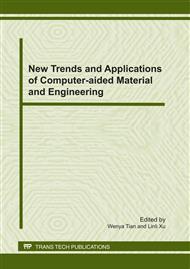[1]
M.A. Piera, M. Narciso and D. Riera: Optimization of logistic and manufacturing systems through simulation: A colored Petri net-based methodology. Simulation-Transactions of the Society for Modeling and Simulation International, Vol 3 (2004).
DOI: 10.1177/0037549704045045
Google Scholar
[2]
Q. Li, J. Gong, J.F. Tang et al: Simulation of the Model of Workers' Assignment in Cellular Manufacturing based on the Multifunctional Workers. 2008 Chinese Control and Decision Conference, Vol 11 (2008): 992~996.
DOI: 10.1109/ccdc.2008.4597461
Google Scholar
[3]
J.Y. Bang, Y.D. Kim: Hierarchical Production Planning for Semiconductor Wafer Fabrication Based on Linear Programming and Discrete-Event Simulation. Ieee Transactions on Automation Science and Engineering, Vol 2 (2010), p.326~336.
DOI: 10.1109/tase.2009.2021462
Google Scholar
[4]
W.J. Selen, J. Ashayeri: Manufacturing cell performance improvement: a simulation study. Robotics and Computer-Integrated Manufacturing, Vol 17 (2010), p.169~176.
DOI: 10.1016/s0736-5845(00)00051-x
Google Scholar
[5]
G. Zuelch: Modeling and Simulation of Human Decision-making in Manufacturing Systems. Proceeding of the 2006 Winter Simulation Conference, (2006), p.947~953.
Google Scholar
[6]
S. Robinson, T. Alifantis, J.S. Edwards et al: Knowledge Based Improvement: Simulation and Artificial Intelligence for Identifying and Improving Human Decision-Making in an Operations System. Journal of the Operational Research Society, Vol 8 (2005).
DOI: 10.1057/palgrave.jors.2601915
Google Scholar
[7]
D.J. Van der Zee: Modeling decision-making and control in manufacturing simulation. International Journal of Production Economics, Vol 1 (2006), p.155~167.
DOI: 10.1016/j.ijpe.2004.11.001
Google Scholar
[8]
K. Laughery, C. Lebiere and S. Archer: Modeling Human Performance in Complex Systems. In: Salvendy, G. (Ed. ), Handbook of Human Factors and Ergonomics, New York, Wiley, (2006), p.967~996.
DOI: 10.1002/0470048204.ch36
Google Scholar
[9]
Z.H. Wang, F. Jiang: Information technology, team production and organizational design of bottom-tier employees. Journal of Management Sciences in China, Vol 4 (2002), p.46~50.
Google Scholar
[10]
G.H. Shi, H. Zhang: Simulation of human-oriented production systems based on cooperration. Machinery Design & Manufacture, (2005), p.88~99.
Google Scholar
[11]
X.D. Zhang, S.Y. Duan, S.Y. Guo et al: Intelligent simulation of complex production systems including expert decision. Journal of Chongqing University, Vol 33 (2010), p.56~59.
Google Scholar


